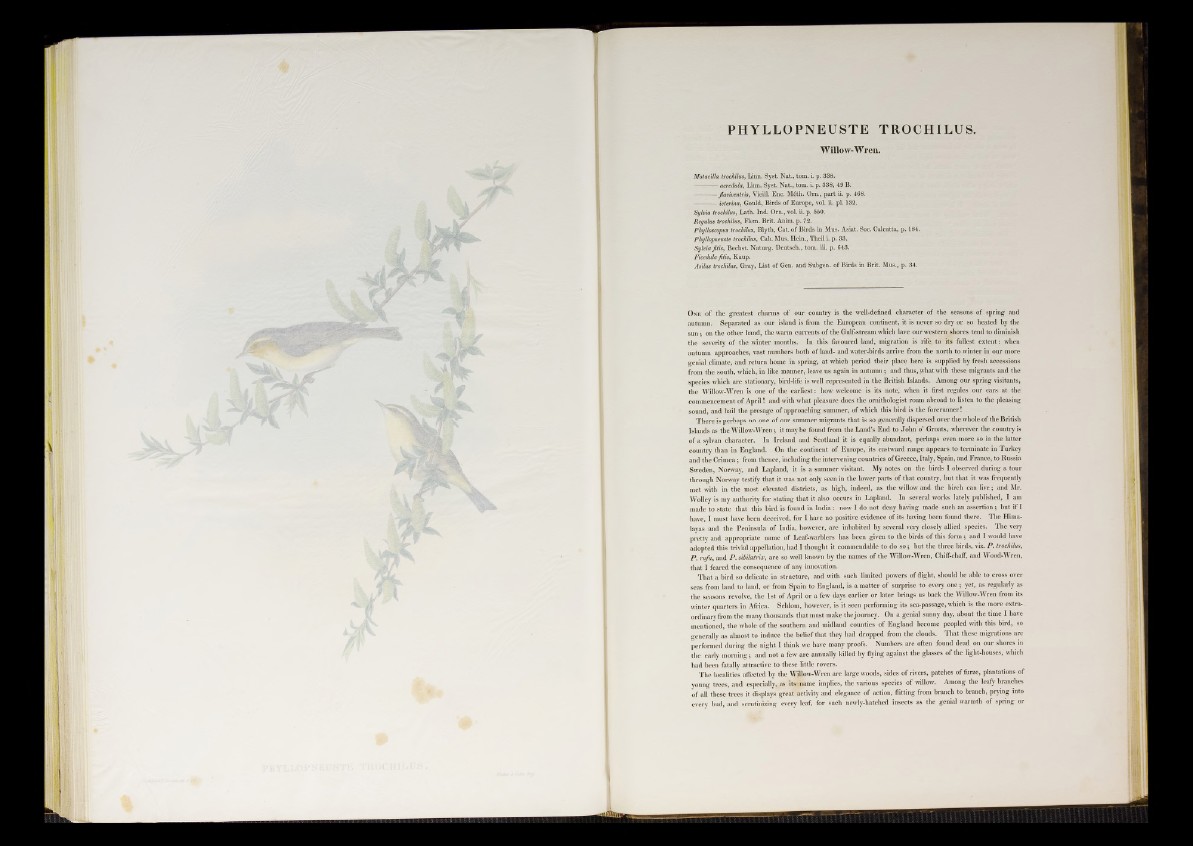
Willow-Wren.
Motacilla irochilus, Linn. Syst. Nat., tom. i. p. 338.
acredula, Linn. Syst. Nat., tom. i. p. 338, 49 B.
flaviventris, VieilL Enc. M6th. Orn., part ii. p. 468.
---------- icterina, Gould, Birds of Europe, vol. ii. pi. 132.
Sylvia irochilus, Lath. Ind. Om., vol. ii. p. 550.
Regulus irochilus, Flem. Brit. Anim. p. 72.
Phylloscopus Irochilus, Blyth, Cat. of Birds in Mus. Asiat. Soc. Calcutta, p. 184.
Phyllopneuste irochilus, Cab. Mus. Hein., Theil i. p. 33.
Sylvia fitis, Bechst. Naturg. Deutsch., tom. iii. p. 643.
Ficedula fitis, Kaup.
Asilus irochilus, Gray, List of Gen. and Subgen. of Birds in Brit. Mus., p. 34.
O n e of the greatest charms of our country is the well-defined character of the seasons of spring and
autumn. Separated as our island is from the European continent, it is never so dry or so heated by the
su n : on the other hand, the warm currents o f the Gulf-stream which lave our western shores tend to diminish
the severity of the winter months. In this favoured land, migration is rife to its fullest extent: when
autumn approaches, vast numbers both of land- and water-birds arrive from the north to winter in our more
genial climate, and return home in spring, at which period their place here is supplied by fresh accessions
from the south, which, in like manner, leave us again in autumn; and thus, what with these migrants and the
species which are stationary, bird-life is well represented in the British Islands. Among our spring visitants,
the Willow-Wren is one of the earliest: how welcome is its note, when it first regales our ears at the
commencement of April! and with what pleasure does the ornithologist roam abroad to listen to the pleasing
sound, and hail the presage of approaching summer, of which this bird is the forerunner!
There is perhaps no one of our summer migrants that is so generally dispersed over the whole of the British
Islands as the Willow-Wren; it maybe found from the Land’s End to John o’ Groats, wherever the country is
of a sylvan character. In Ireland and Scotland it is equally abundant, perhaps even more so in the latter
country than in England. On the continent of Europe, its eastward range appears to terminate in Turkey
and the Crimea; from thence, including the intervening countries of Greece, Italy, Spain, and France, to Russia
Sweden, Norway, and Lapland, it is a summer visitant. My notes on the birds I observed during a tour
through Norway testify that it was not only seen in the lower parts of that country, but that it was frequently
met with in the most elevated districts, as high, indeed, as the willow and the birch can live; and Mr.
Wolley is my authority for stating that it also occurs in Lapland. In several works lately published, I am
made to state that this bird is found in In d ia : now I do not deny having made such an assertion; but if I
have, I must have been deceived, for I have no positive evidence of its having been found there. The Himalayas
and the Peninsula of India, however, are inhabited by several very closely allied species. The very
pretty and appropriate name of Leaf-warblers has been given to the birds of this form; and I would have
adopted this trivial appellation, had I thought it commendable to do s o ; but the three birds, viz. P. trochilus,
P. mfa, and P. sibilatriw, are so well known by the names of the Willow-Wren, Chiff-chaff, and Wood-Wren,
that I feared the consequence of any innovation.
That a bird so delicate in structure, and with such limited powers of flight, should be able to cross over
seas from land to land, or from Spain to England, is a matter of surprise to every o n e ; yet, as regularly as
the seasons revolve, the 1st of April or a few days earlier or later brings us back the Willow-Wren from its
winter quarters in Africa. Seldom, however, is it seen performing its sea-passage, which is the more extra-.
ordinary from the many thousands that must make the journey. On a genial sunny day, about the time I have
mentioned, the whole of the southern and midland counties of England become peopled with this bird, so
generally as almost to induce the belief that they had dropped from the clouds. That these migrations are
performed during the night I think we have many proofs. Numbers are often found dead on our shores in
the early morning; and not a few are annually killed by flying against the glasses of the light-houses, which
had been fatally attractive to these little rovers.
The localities affected by the Willow-Wren are large woods, sides of rivers, patches of furze, plantations of
young trees, and especially, as its*name implies, the various species of willow. Among the leafy branches
of all these trees it displays great activity and elegance of action, flitting from branch to branch, prying into
every bud, and scrutinizing every leaf, for such newly-hatched insects as the genial warmth of spring or